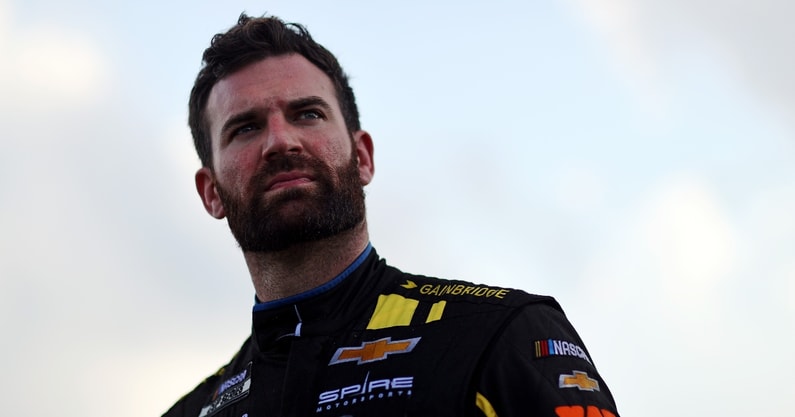
Denny Hamlin Labels Corey LaJoie as His Own Worst Enemy Following Michigan Accident
In the aftermath of a dramatic incident at Michigan International Speedway, NASCAR driver Denny Hamlin has publicly criticized fellow driver Corey LaJoie, labeling him as his “own worst enemy.” The comment, which has generated significant buzz in the racing community, stems from a controversial collision that took place during the race, leading to a series of repercussions for both drivers and their respective teams. Hamlin’s remarks shed light on the tensions and frustrations that often arise in high-stakes racing environments.
**The Michigan Accident**
The accident in question occurred during a pivotal stage of the NASCAR Cup Series race at Michigan International Speedway. As the race entered its final laps, a critical incident involving Denny Hamlin and Corey LaJoie unfolded. According to race reports and video footage, Hamlin and LaJoie were engaged in a tight battle on the track when LaJoie made contact with Hamlin’s car, causing a significant crash that not only affected both drivers but also had implications for the rest of the field.
Hamlin’s car was severely damaged in the collision, resulting in a race-ending situation for him. The crash also had repercussions for LaJoie, whose vehicle sustained damage that impacted his performance and led to a disappointing finish. The incident sparked immediate controversy, with fans and analysts debating the responsibility and the potential causes of the crash.
**Hamlin’s Critique of LaJoie**
Following the race, Denny Hamlin did not hold back in expressing his frustration with LaJoie. In a series of post-race interviews and social media posts, Hamlin labeled LaJoie as his “own worst enemy,” attributing the accident and its fallout to what he perceived as poor judgment and reckless driving on LaJoie’s part. Hamlin’s criticism was rooted in his belief that LaJoie’s actions were not only detrimental to Hamlin’s race but also reflected a broader pattern of risky behavior that has plagued LaJoie’s racing career.
Hamlin argued that LaJoie’s aggressive driving style and lack of consideration for the potential consequences contributed to the accident. He suggested that LaJoie’s tendency to make bold moves without fully assessing the situation led to the collision, which he saw as an avoidable error. This perspective highlights the inherent tension in racing, where split-second decisions and aggressive strategies can have far-reaching impacts on both competitors and the race itself.
**The Broader Context**
Hamlin’s remarks come against a backdrop of ongoing debates within the NASCAR community about racing etiquette and the balance between aggression and safety. The high-speed, high-stakes environment of NASCAR often leads to intense rivalries and heated exchanges between drivers. The Michigan accident is a prime example of how these dynamics play out on the track, with drivers like Hamlin and LaJoie representing different approaches to racing.
While Hamlin’s criticism reflects his personal perspective, it also taps into broader concerns about driver behavior and accountability. NASCAR has faced scrutiny over the years regarding its handling of incidents and the enforcement of rules designed to ensure safe racing conditions. The incident involving Hamlin and LaJoie has reignited discussions about the need for clearer guidelines and stricter penalties for reckless driving.
**Impact on the Drivers and Teams**
The fallout from the Michigan accident has had significant implications for both drivers and their teams. For Hamlin, the crash resulted in a disappointing finish and potential setbacks in his championship aspirations. The damage to his car and the subsequent repair costs also place an additional financial burden on his team.
For LaJoie, the criticism from Hamlin and the negative attention from the racing community represent a challenge to his reputation and career. While LaJoie has defended his actions and expressed regret for the incident, the label of being his “own worst enemy” could impact his standing among fans and fellow drivers. LaJoie’s team will need to address both the physical damage to the car and the strategic adjustments required to move forward.
**Looking Ahead**
As NASCAR moves forward from the Michigan incident, both Denny Hamlin and Corey LaJoie will need to navigate the aftermath and its implications for their racing careers. Hamlin’s criticism of LaJoie serves as a reminder of the intense emotions and high stakes involved in the sport. For LaJoie, it is an opportunity to reflect on his driving style and seek ways to improve his approach on the track.
The incident highlights the ongoing challenges of balancing aggression with safety in NASCAR and underscores the need for continued dialogue and improvement within the sport. As both drivers continue their seasons, the lessons learned from the Michigan accident will likely influence their strategies and interactions moving forward.
Leave a Reply